
 |
Tea Clipper |
 |
| from TeaAntiques.com | ||
| Edition Eighty Nine |
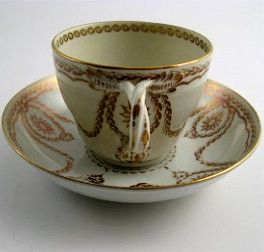
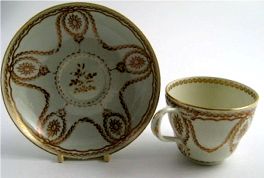 A
very attractive and rare 'James Giles' decorated teacup and saucer, c1775. James
Giles was a famous decorator who decorated this Worcester teacup and saucer in his
London studio. It is charmingly decorated with a neo-classical design of 'gilt star
and husk swags' in fine gilding.
A
very attractive and rare 'James Giles' decorated teacup and saucer, c1775. James
Giles was a famous decorator who decorated this Worcester teacup and saucer in his
London studio. It is charmingly decorated with a neo-classical design of 'gilt star
and husk swags' in fine gilding.
One very charming feature of this teacup is the interlaced foliate handles. This delicate design has moulded leaves terminating the handles to the body of the cup.
The handle and leaf terminals are finely embellished with gilt decoration. It should be noted that this decoration includes diminishing sized dots on the leaf terminals and along the back edge of the intertwined handles - this a know feature of Giles decorated pieces. A very fine item for the collector of early Worcester or James Giles decorated pieces.
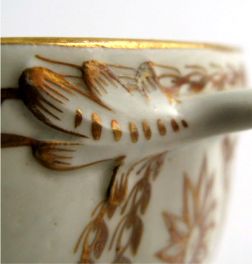
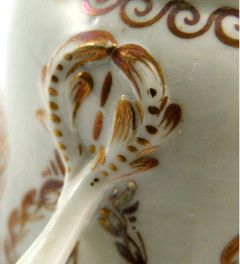
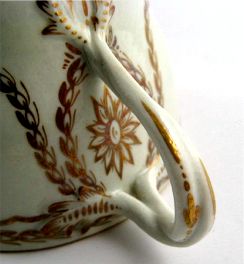
More details of this item and other tea related antiques can be found by visiting my web site at www.TeaAntiques.com.
Following my previous Tea Clipper where I featured Kew Palace that is located
within Kew Gardens,
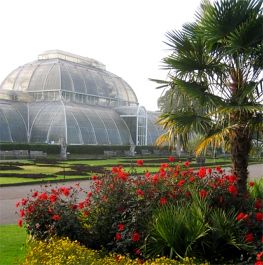 I
thought you may enjoy seeing what else Kew Gardens has to offer the visitor.
I
thought you may enjoy seeing what else Kew Gardens has to offer the visitor.
My visit to Kew was in the autumn of 2007, a time when there was still some late summer flowering plants with their vivid colours but also some of the tree leaves turning colour to their brilliant autumnal shades.
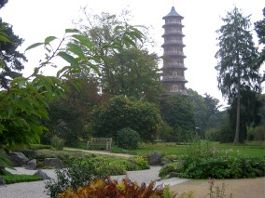 The
Royal Botanical Gardens at Kew have evolved over hundreds of years and now provide
a rich horticultural tapestry, with strange and wonderful plants from all round
the world, grown with in confines. The gardens cover over 300 acres and with a lot
to see, it certainly needs at least one full day to enjoy all that it has to offer.
As well as a garden of beauty for us all to enjoy, it has another function in conservation
and research, understanding the world's plants and ensuring that they remain with
us for years to come.
The
Royal Botanical Gardens at Kew have evolved over hundreds of years and now provide
a rich horticultural tapestry, with strange and wonderful plants from all round
the world, grown with in confines. The gardens cover over 300 acres and with a lot
to see, it certainly needs at least one full day to enjoy all that it has to offer.
As well as a garden of beauty for us all to enjoy, it has another function in conservation
and research, understanding the world's plants and ensuring that they remain with
us for years to come.
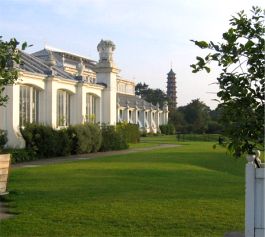 As
well as the gardens and its diversity of trees and plants, there are within the
gardens many of the architectural features from the time of George III and Queen
Charlotte. These include the famous Pagoda, Queen Charlotte's cottage, The Orangery
as well as Kew Palace itself. Also, there are the expanses of glass houses in which
there are many tropical and heat loving plants that would otherwise not survive
the English climate. As I was to discover, in one of the conservatories, they were
growing tea!
As
well as the gardens and its diversity of trees and plants, there are within the
gardens many of the architectural features from the time of George III and Queen
Charlotte. These include the famous Pagoda, Queen Charlotte's cottage, The Orangery
as well as Kew Palace itself. Also, there are the expanses of glass houses in which
there are many tropical and heat loving plants that would otherwise not survive
the English climate. As I was to discover, in one of the conservatories, they were
growing tea!
My tour begins at Lion Gate entrance, one of four gates into the gardens. My first port of call was to the Pagoda, which is not far from Lion Gate. This absolutely amazing structure is one of the buildings dating from the eighteenth century. It was started in the autumn of 1761 to the design of Sir William Chambers. It towers over the trees and gardens to a height of almost 50 metres. Inside, a simple spiral staircase winds its way to the top where magnificent views over the gardens can be seen. However, the Pagoda is currently undergoing some restoration and urgent repairs, so is closed for the next few years. That said, it still provides a wonderful sight within the garden landscape and at various points in the garden, there are long 'pagoda views' down through the avenues of trees.
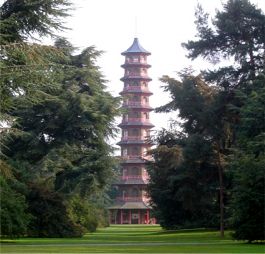
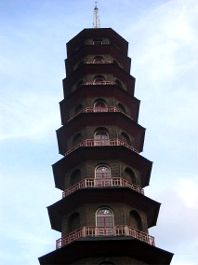
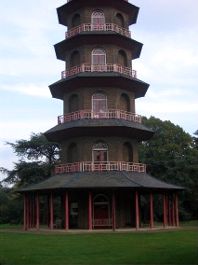
From the Pagoda, I made my way across a short distance to the Japanese garden, this very cleverly laid out and planted to give a dry 'water feature' landscape using pale blue gravel instead of water. With the wooden temple, rocks and choice planting, it made a very attractive Japanese style garden within the English gardens.
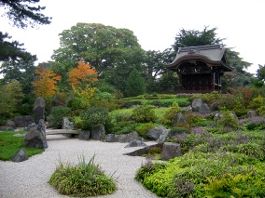
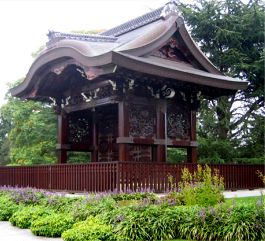
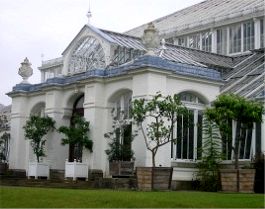
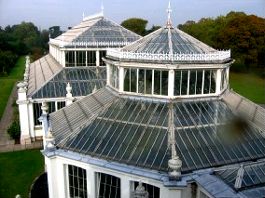 Turning
North, I proceeded along the varied tree lined walks to the Temperate House, an
incredible Victorian structure of glass and cast iron. This is the largest of three
glass houses at Kew and growing in the centre of the glass house a Chilean Wine
Palm, which at over 16 metres, is believed to be the world's tallest indoor plant.
The glass house is divided into different world temperate zones and in one there
I discovered that they were attempting to grow a tea plant, Camellia Sinensis.
I have to say, that it was rather a small and rather weedy young specimen, which
I hope in time will grow into a beautiful plant. It is labelled with its name and
also a little board with some tea history and other information - so worth keeping
a look out for this. A spiral cast iron staircase allows you to reach the walkways
round the roof level of the glass house. From this high platform you can walk at
tree height and look down on the plants and pond below.
Turning
North, I proceeded along the varied tree lined walks to the Temperate House, an
incredible Victorian structure of glass and cast iron. This is the largest of three
glass houses at Kew and growing in the centre of the glass house a Chilean Wine
Palm, which at over 16 metres, is believed to be the world's tallest indoor plant.
The glass house is divided into different world temperate zones and in one there
I discovered that they were attempting to grow a tea plant, Camellia Sinensis.
I have to say, that it was rather a small and rather weedy young specimen, which
I hope in time will grow into a beautiful plant. It is labelled with its name and
also a little board with some tea history and other information - so worth keeping
a look out for this. A spiral cast iron staircase allows you to reach the walkways
round the roof level of the glass house. From this high platform you can walk at
tree height and look down on the plants and pond below.

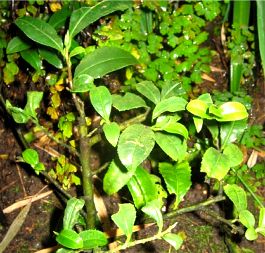
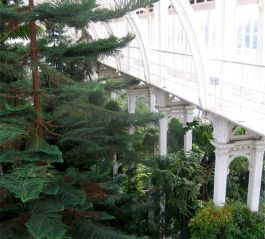
Leaving the Temperate House by the North door you can walk along the Cherry Walk, so named as it is a walk lined with young cherry trees, to King William's temple. This is a nicely proportioned neo-classical temple having a columned front supporting a triangular pediment in which are carved King William's initials. At the front of the temple stands two white wooden orange pots with orange tree in them.
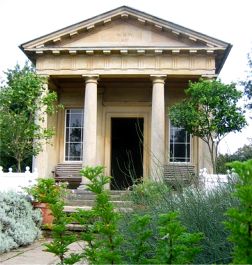
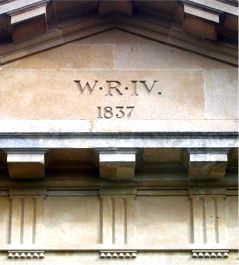
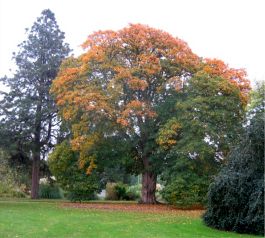
Taking a turn to the right, I skirted past the Temple of Bellona, another neo-classical temple, this time with a domed roof. Nearby a tree had turned a beautiful burning red at the top of its crown, making a stunning picture next to the temple.
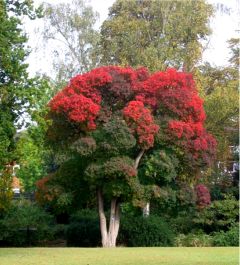
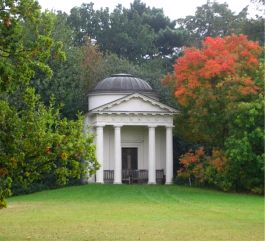
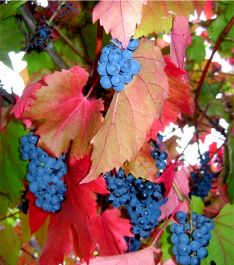
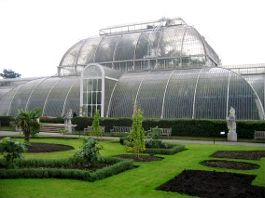
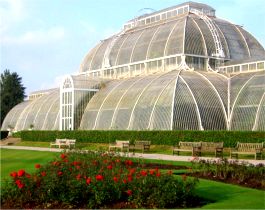 Now
I headed right towards the fantastically elegant Palm House. This, the second of
the huge glass houses is a testament to the brilliance of the Victorian engineers,
creating a structure of such proportions and style. Inside an array of mature palm
trees and other exotic plants and flowers. As with the Temperate House, there are
walkways round the top of the structure reached by spiral cast iron staircases.
On a cool Autumn day it is a treat to walk around this mild and humid microclimate.
As well as the beautiful plants, underneath the glass house, there is an aquarium
housing many world wide species of fish.
Now
I headed right towards the fantastically elegant Palm House. This, the second of
the huge glass houses is a testament to the brilliance of the Victorian engineers,
creating a structure of such proportions and style. Inside an array of mature palm
trees and other exotic plants and flowers. As with the Temperate House, there are
walkways round the top of the structure reached by spiral cast iron staircases.
On a cool Autumn day it is a treat to walk around this mild and humid microclimate.
As well as the beautiful plants, underneath the glass house, there is an aquarium
housing many world wide species of fish.
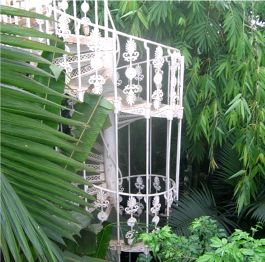
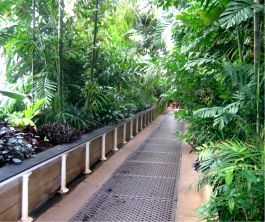
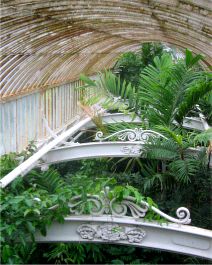
On the West side of the Palm House are colourful flower beds of roses and on the East, beds are planted each year with a different theme. This side of the glasshouse overlooks the lake towards the 'Plants and People' exhibition, houses in a fine nineteenth century yellow brick building.
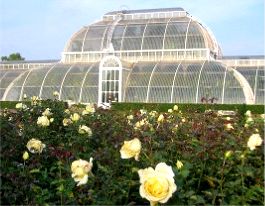
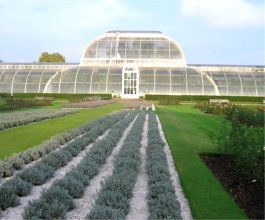
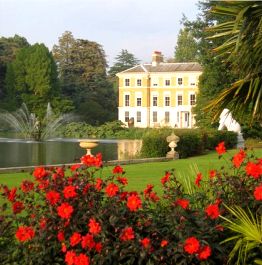
Continuing to the North-East corner of the gardens is the third of the glass houses, this the 'Princess of Wales' conservatory, the newest of the three. This is a modern structure with angular outline in concrete, steel and glass. In here you can discover plants from ten climatic zones, form the hot dry to the moist warm and humid. Plants from cacti to beautiful orchids grow in abundance.
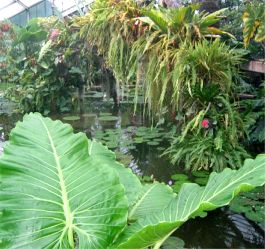
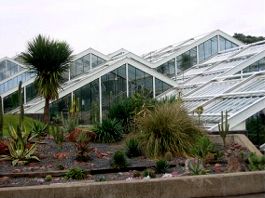
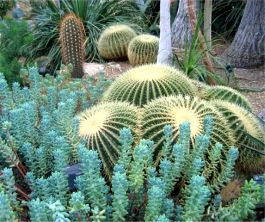
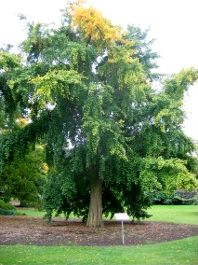
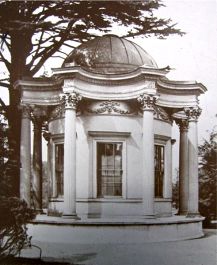 On
my way from here to the Orangery Restaurant to take some refreshments, I passed
through a Ginkgo plantation. One of the fine specimens of
Ginkgo
Biloba was planted by Queen Mary . It is planted on the site of the 'Temple
of the Sun', a Sir William Chambers' building from 1761, that was destroyed in a
storm on 26th march 1916. The Ginkgo tree has delightful fern like leaves that turn
a stunning soft yellow in the Autumn. As well as the sheer beauty of this tree in
the garden, it also provides some useful medicinal benefits to us. For over 2,000
years it has been known to assist blood flow, particularly to our brain and body
extremities, such as hands. So, for those who feel the cold of winter with numb
and white fingers due to lack of blood reaching them, this tree provides a wonderful
natural solution.
On
my way from here to the Orangery Restaurant to take some refreshments, I passed
through a Ginkgo plantation. One of the fine specimens of
Ginkgo
Biloba was planted by Queen Mary . It is planted on the site of the 'Temple
of the Sun', a Sir William Chambers' building from 1761, that was destroyed in a
storm on 26th march 1916. The Ginkgo tree has delightful fern like leaves that turn
a stunning soft yellow in the Autumn. As well as the sheer beauty of this tree in
the garden, it also provides some useful medicinal benefits to us. For over 2,000
years it has been known to assist blood flow, particularly to our brain and body
extremities, such as hands. So, for those who feel the cold of winter with numb
and white fingers due to lack of blood reaching them, this tree provides a wonderful
natural solution.
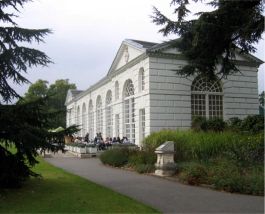 Reaching
the Orangery Restaurant, I was pleased to have a short rest and to try their scones,
cream and jam. The scone was a good size, very crispy on the outside and soft on
the inside, rather pleasant. There were some good looking cakes on display in the
self service area, but I resisted these! I enjoyed the tea and break. However, I
do not like it when milk is of the UHT variety in those nasty little plastic cartons
that you can never easily open - which is what they serve here! As they go to the
trouble of providing tea in teapots, why not use little jugs of fresh milk to accompany
them, it would be a great improvement. The Orangery itself is a handsome Grade I
listed building from the eighteenth century.
Reaching
the Orangery Restaurant, I was pleased to have a short rest and to try their scones,
cream and jam. The scone was a good size, very crispy on the outside and soft on
the inside, rather pleasant. There were some good looking cakes on display in the
self service area, but I resisted these! I enjoyed the tea and break. However, I
do not like it when milk is of the UHT variety in those nasty little plastic cartons
that you can never easily open - which is what they serve here! As they go to the
trouble of providing tea in teapots, why not use little jugs of fresh milk to accompany
them, it would be a great improvement. The Orangery itself is a handsome Grade I
listed building from the eighteenth century.
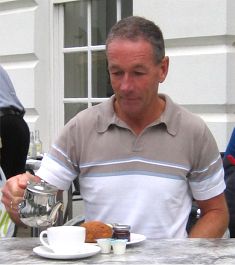
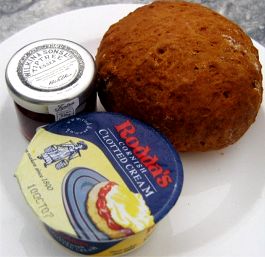

Suitably refreshed, I visited Kew Palace, which I reported in previous 'Tea Clipper'. From Kew Palace, which is right at the North end of the gardens next to the River Thames, I made my way back across the gardens towards Queen Charlotte's Cottage in the South-West corner. On my way, I passed through many interesting and varied planted areas and woodland. I had to cross the lake that is in the centre of the garden. It is now possible to cross the lake using the relatively new and modern 'Sackler Crossing'. this a bridge that not only provides us a way across the lake, but also a crossing for the peacocks and perch for the seagulls on the lines of posts forming the sides of the bridge.
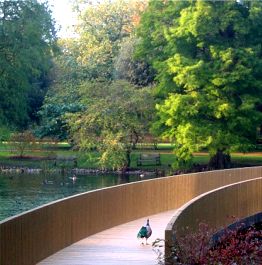
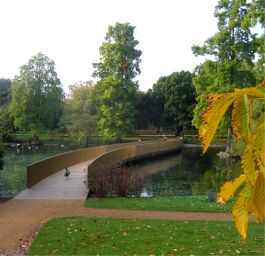
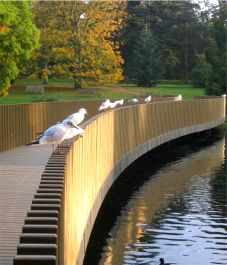
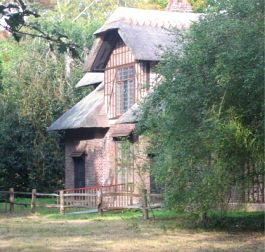
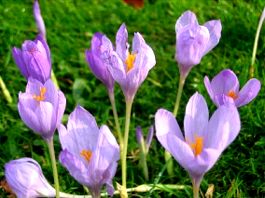 Eventually,
I reached Queen Charlotte's Cottage, built in natural looking forest, it is of brick
and timber construction, with a thatched roof and leaded light windows. This cottage
was used by King George III and Queen Charlotte to take tea or somewhere to have
a picnic. A rural retreat that they could enjoy away from the rigours of a more
formal life they had to endure. This cottage would look particularly pretty in May
when it is surrounded by a carpet of Bluebells. Sadly, this cottage is rarely open
to the public. The pictures of the interior in the guide books show the interior
to be far from cottage like. On the ground floor there is a Print Room, the walls
hung with Hogarth prints. Such print rooms were very fashionable in the later part
of the Eighteenth century. There is a handsome marble chimney piece with a hob-grate,
the floor of this room is of stone in a geometric design. Above this room is the
Upper Chamber which affords fine views out into the forest and in which the Royal
family could enjoy taking their afternoon tea.
Eventually,
I reached Queen Charlotte's Cottage, built in natural looking forest, it is of brick
and timber construction, with a thatched roof and leaded light windows. This cottage
was used by King George III and Queen Charlotte to take tea or somewhere to have
a picnic. A rural retreat that they could enjoy away from the rigours of a more
formal life they had to endure. This cottage would look particularly pretty in May
when it is surrounded by a carpet of Bluebells. Sadly, this cottage is rarely open
to the public. The pictures of the interior in the guide books show the interior
to be far from cottage like. On the ground floor there is a Print Room, the walls
hung with Hogarth prints. Such print rooms were very fashionable in the later part
of the Eighteenth century. There is a handsome marble chimney piece with a hob-grate,
the floor of this room is of stone in a geometric design. Above this room is the
Upper Chamber which affords fine views out into the forest and in which the Royal
family could enjoy taking their afternoon tea.
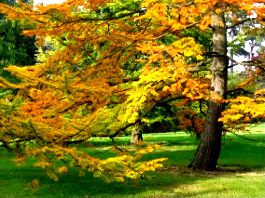
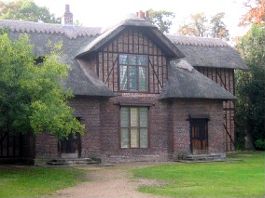
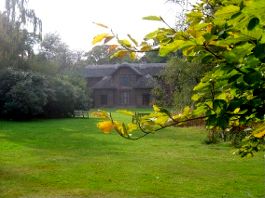
Leaving Queen Charlotte's Cottage behind, it was then a walk East back to Lion gate. This walk gave some fine views of the Pagoda once more in the late afternoon sunshine. the end of a most enjoyable day and visit to Kew gardens. A garden for all seasons.
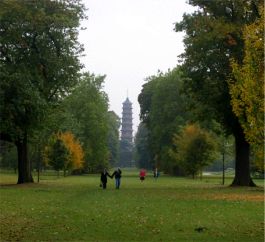
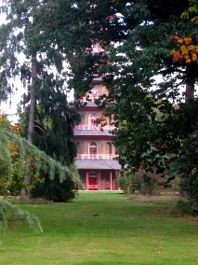
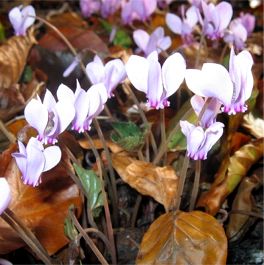
To review past newsletters, just follow this link:
Past newsletters.
To subscribe to this free newsletter -
Click here